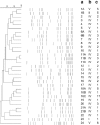Emergence of SCCmec type IV and SCCmec type V methicillin-resistant Staphylococcus aureus containing the Panton-Valentine leukocidin genes in a large academic teaching hospital in central Switzerland: external invaders or persisting circulators?
- PMID: 20042625
- PMCID: PMC2832439
- DOI: 10.1128/JCM.01890-09
Emergence of SCCmec type IV and SCCmec type V methicillin-resistant Staphylococcus aureus containing the Panton-Valentine leukocidin genes in a large academic teaching hospital in central Switzerland: external invaders or persisting circulators?
Abstract
The hospital epidemiology of methicillin-resistant Staphylococcus aureus (MRSA) has changed in the past few years due to the encroachment of community-associated MRSA (CA-MRSA) strains into health care settings. MRSA strains that were isolated during a 2-year period from patients of the Luzerner Kantonsspital were analyzed to elucidate their epidemiology. Moreover, extended surveillance of individuals who were contacts of those patients was carried out for 6 months to identify the routes of spread and to assess the quality of the infection control measures used in our setting. Patient data were collected to distinguish CA-MRSA strains from health care-associated MRSA (HA-MRSA) strains by epidemiological criteria, as defined by the Centers for Disease Control and Prevention (CDC). On the basis of the CDC definition, the majority of the strains were considered to be HA-MRSA. However, 87% of them belonged to staphylococcal cassette chromosome mec (SCCmec) types IV and V, which are traditionally associated with CA-MRSA. Surprisingly, classical nosocomial SCCmec types I and II represented a minority, whereas SCCmec type III was completely absent. By PFGE analysis, four predominant clonal lineages and 21 highly variable sporadic genotypes were detected. Twenty-eight percent of the MRSA strains studied carried the genes encoding the Panton-Valentine leukocidin (PVL), of which 21% and 83% were associated with SCCmec types IV and V, respectively. Among 289 contact individuals screened for MRSA carriage throughout the extended surveillance, a single secondary patient was discovered. The possibility of nosocomial transmission could be excluded. The high proportions of SCCmec type IV and V strains as well as PVL-positive strains suggest strong infiltration of CA-MRSA into our institution. Moreover, the low endemic prevalence of MRSA demonstrates that current infection control measures are sufficient to limit its spreading and the emergence of large epidemic outbreaks.
Figures




Similar articles
-
Emergence of SCCmec type IV as the most common type of methicillin-resistant Staphylococcus aureus in a university hospital.Infection. 2009 Feb;37(1):44-8. doi: 10.1007/s15010-008-7430-7. Epub 2008 Oct 30. Infection. 2009. PMID: 18974930
-
Molecular characterization of methicillin-resistant Staphylococcus aureus with emergence of epidemic clones of sequence type (ST) 22 and ST 772 in Mumbai, India.J Clin Microbiol. 2010 May;48(5):1806-11. doi: 10.1128/JCM.01867-09. Epub 2010 Mar 29. J Clin Microbiol. 2010. PMID: 20351212 Free PMC article.
-
Molecular epidemiology of methicillin-resistant and methicillin-susceptible Staphylococcus aureus isolated from the eye.Curr Eye Res. 2011 Feb;36(2):94-102. doi: 10.3109/02713683.2010.534229. Epub 2010 Dec 15. Curr Eye Res. 2011. PMID: 21158584 Free PMC article.
-
The evolution of Staphylococcus aureus.Infect Genet Evol. 2008 Dec;8(6):747-63. doi: 10.1016/j.meegid.2008.07.007. Epub 2008 Jul 29. Infect Genet Evol. 2008. PMID: 18718557 Review.
-
Molecular Epidemiological Features of Methicillin-Resistant Staphylococcus aureus in Japan.Biol Pharm Bull. 2025;48(3):196-204. doi: 10.1248/bpb.b23-00685. Biol Pharm Bull. 2025. PMID: 40024689 Review.
Cited by
-
Antibiotic Resistance and Virulence Gene Characteristics of Methicillin-Resistant Staphylococcus aureus (MRSA) Isolated from Healthy Edible Marine Fish.Int J Microbiol. 2020 Jun 4;2020:9803903. doi: 10.1155/2020/9803903. eCollection 2020. Int J Microbiol. 2020. PMID: 32565817 Free PMC article.
-
Detection of methicillin-resistant Staphylococcus aureus (MRSA) from nasal samples by multiplex real-time PCR based on dual priming AT-rich primers.Folia Microbiol (Praha). 2012 Jan;57(1):37-45. doi: 10.1007/s12223-011-0085-2. Epub 2011 Dec 22. Folia Microbiol (Praha). 2012. PMID: 22187362
-
Genotypic and Phenotypic-Based Assessment of Antibiotic Resistance and Profile of Staphylococcal Cassette Chromosome mec in the Methicillin-Resistant Staphylococcus aureus Recovered from Raw Milk.Infect Drug Resist. 2020 Jan 30;13:273-283. doi: 10.2147/IDR.S229499. eCollection 2020. Infect Drug Resist. 2020. PMID: 32099419 Free PMC article.
-
Carriage frequency, phenotypic, and genotypic characteristics of methicillin-resistant Staphylococcus aureus isolated from dental health-care personnel, patients, and environment.Sci Rep. 2017 Aug 7;7(1):7390. doi: 10.1038/s41598-017-07713-8. Sci Rep. 2017. PMID: 28784993 Free PMC article.
-
Clonal spreading of methicillin-resistant SCCmec Staphylococcus aureus with specific spa and dru types in central Taiwan.Eur J Clin Microbiol Infect Dis. 2012 Apr;31(4):499-504. doi: 10.1007/s10096-011-1338-3. Epub 2011 Jul 26. Eur J Clin Microbiol Infect Dis. 2012. PMID: 21789606
References
-
- Blanc, D. S., D. Pittet, C. Ruef, A. F. Widmer, K. Mühlemann, C. Petignat, S. Harbarth, R. Auckenthaler, J. Bille, R. Frei, R. Zbinden, P. Moreillon, P. Sudre, and P. Francioli. 2002. Molecular epidemiology of predominant clones and sporadic strains of methicillin resistant Staphylococcus aureus in Switzerland and comparison with European epidemic clones. Clin. Microbiol. Infect. 8:419-426. - PubMed
-
- Carrico, J. A., F. R. Pinto, C. Simas, S. Nunes, N. G. Sousa, N. Frazao, H. de Lencastre, and J. S. Almeida. 2005. Assessment of band-based similarity coefficients for automatic type and subtype classification of microbial isolates analyzed by pulsed-field gel electrophoresis. J. Clin. Microbiol. 43:5483-5490. - PMC - PubMed
-
- Centers for Disease Control and Prevention. 2005, posting date. Community associated MRSA information for clinicians. Infection control topics. Centers for Disease Control and Prevention, Atlanta, GA. www.cdc.gov/ncidod/dhqp/ar_mrsa_ca_clinicians.html.
Publication types
MeSH terms
Substances
LinkOut - more resources
Full Text Sources
Medical
Miscellaneous

